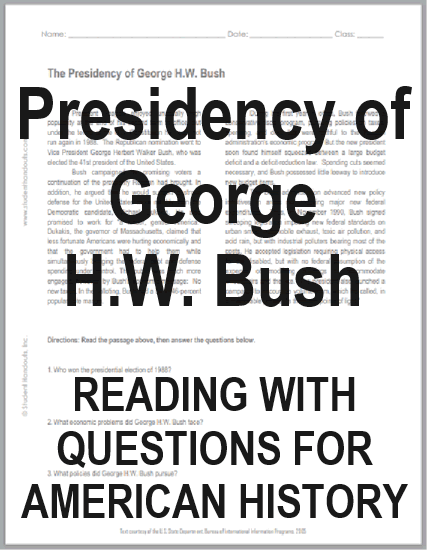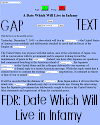| The Presidency of George H.W. Bush Reading with Questions |
|---|
| www.studenthandouts.com ↣ American History ↣ American History Readings |
|
President Reagan enjoyed unusually high popularity at the end of his second term in office, but under the terms of the U.S. Constitution he could not run again in 1988. The Republican nomination went to Vice President George Herbert Walker Bush, who was elected the 41st president of the United States.
Bush campaigned by promising voters a continuation of the prosperity Reagan had brought. In addition, he argued that he would support a strong defense for the United States more reliably than the Democratic candidate, Michael Dukakis. He also promised to work for "a kinder, gentler America." Dukakis, the governor of Massachusetts, claimed that less fortunate Americans were hurting economically and that the government had to help them while simultaneously bringing the federal debt and defense spending under control. The public was much more engaged, however, by Bush's economic message: No new taxes. In the balloting, Bush had a 54-to-46-percent popular vote margin. |
 |
    |
|
During his first year in office, Bush followed a conservative fiscal program, pursuing policies on taxes, spending, and debt that were faithful to the Reagan administration's economic program. But the new president soon found himself squeezed between a large budget deficit and a deficit-reduction law. Spending cuts seemed necessary, and Bush possessed little leeway to introduce new budget items.
The Bush administration advanced new policy initiatives in areas not requiring major new federal expenditures. Thus, in November 1990, Bush signed sweeping legislation imposing new federal standards on urban smog, automobile exhaust, toxic air pollution, and acid rain, but with industrial polluters bearing most of the costs. He accepted legislation requiring physical access for the disabled, but with no federal assumption of the expense of modifying buildings to accommodate wheelchairs and the like. The president also launched a campaign to encourage volunteerism, which he called, in a memorable phrase, "a thousand points of light." Directions: Read the text above, then answer the questions below. 1. Who won the presidential election of 1988? 2. What economic problems did George H.W. Bush face? 3. What policies did George H.W. Bush pursue? Click here to print this worksheet. Answers will vary. |
| UNIT I: | Early America | UNIT IX: | Discontent and Reform | ||
| UNIT II: | Colonial Period | UNIT X: | War, Prosperity, and Depression | ||
| UNIT III: | American Revolution | UNIT XI: | New Deal and World War II | ||
| UNIT IV: | New National Government | UNIT XII: | Postwar America | ||
| UNIT V: | Westward Expansion | UNIT XIII: | Decades of Change | ||
| UNIT VI: | Sectional Conflict | UNIT XIV: | New Conservatism | ||
| UNIT VII: | Civil War and Reconstruction | UNIT XV: | Into the Twenty-first Century | ||
| UNIT VIII: | Growth and Transformation | UNIT XVI: | Polarization and Deglobalization |
| www.studenthandouts.com ↣ American History ↣ American History Readings |








